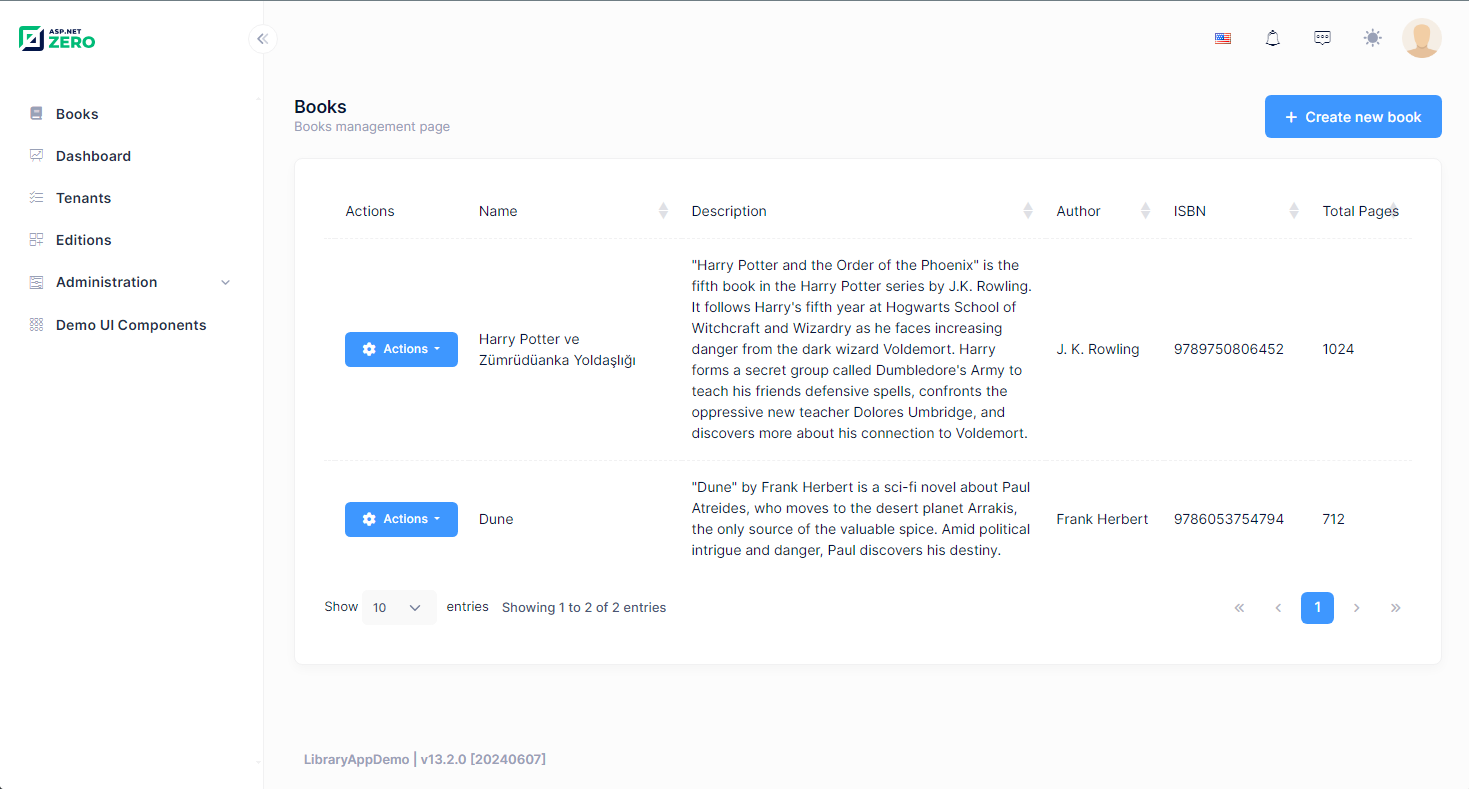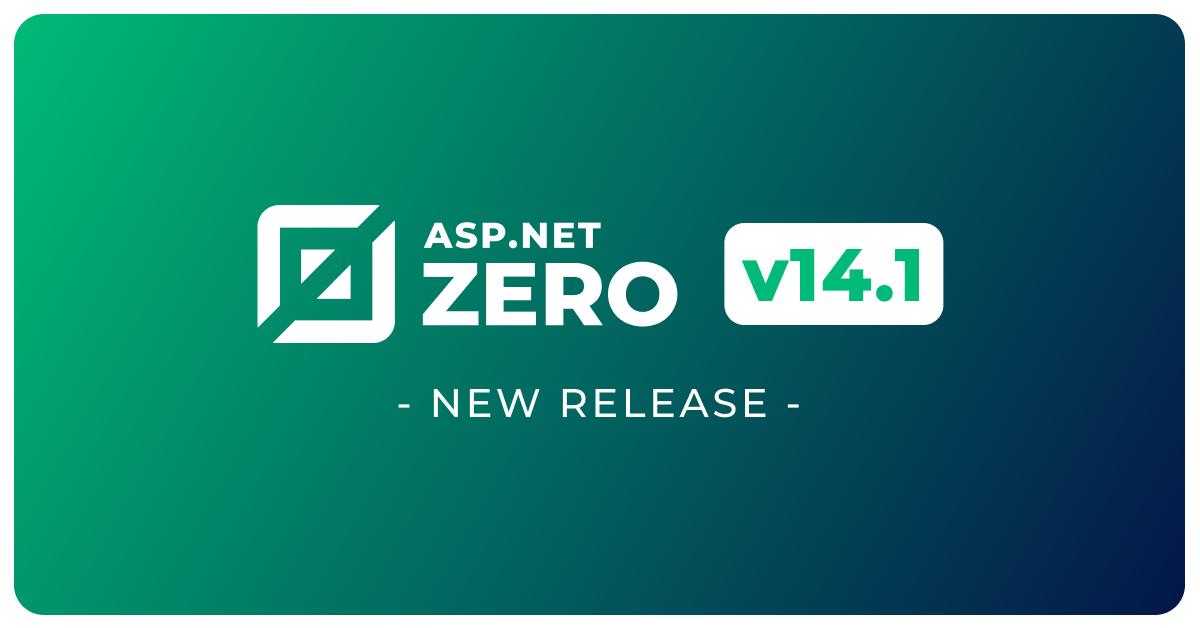After the rise of Microservice architecture, Modular Monolith became popular nowadays. ASP.NET Zero, a powerful framework for building enterprise applications, supports this architecture elegantly. In this blog post, we'll explore how to create a modular monolith application using ASP.NET Zero, complete with an example project and step-by-step instructions.
What is a Modular Monolith?
A modular monolith is a single application that is logically divided into different modules. Each module is self-contained, with its own domain, but they all run within a single process. This approach combines the best of both worlds: the simplicity and performance of monoliths and the modularity and scalability of microservices.
Example Project: Building a Library Application
To demonstrate how to build a modular monolith application with ASP.NET Zero, let's create a library management system. Our application will have BookTracking module. If you want, you can create more modules like the example here.
In this article, I will focus on how to implement a modular structure. I will not cover the details of the ASP.NET Zero. If you are new to ASP.NET Zero, I recommend checking out the official documentation.
First, download a new template from the ASP.NET Zero website. Choose the
ASP.NET Coreoption and select theASP.NET Core MVCtemplate.In your solution, create a new folder named
modules.Create a subfolder named
BookTrackinginside themodulesfolder.
Let's dive into the steps to create the BookTracking module.
1. Add Core Project:
Add class library project named BookTracking.Core inside BookTracking folder. This project will contain the domain entities for the BookTracking module. Setting the project location to {SolutionPath}/modules/BookTracking ensures proper organization.
Add following nuget packages to the BookTracking.Core project:
<ItemGroup>
<PackageReference Include="Abp.AspNetZeroCore" Version="5.0.0" />
<PackageReference Include="Abp.AutoMapper" Version="9.3.0" />
<PackageReference Include="Abp.ZeroCore.EntityFrameworkCore" Version="9.3.0" />
</ItemGroup>
Core Module
Add following classes to the BookTracking.Core project:
BookTrackingConsts.cs
namespace BookTracking.Core;
public class BookTrackingConsts
{
public const string LocalizationSourceName = "BookTracking";
public const bool MultiTenancyEnabled = true;
}
BookTrackingCoreModule
using System.Reflection;
using Abp.AspNetZeroCore;
using Abp.AutoMapper;
using Abp.Modules;
using Abp.Zero;
using BookTracking.Core.Localization;
using BookTracking.Core.Settings;
namespace BookTracking.Core;
[DependsOn(
typeof(AbpZeroCoreModule),
typeof(AbpAutoMapperModule),
typeof(AbpAspNetZeroCoreModule)
)]
public class BookTrackingCoreModule : AbpModule
{
public override void PreInitialize()
{
Configuration.Settings.Providers.Add<BookTrackingSettingProvider>();
BookTrackingLocalizationConfigurer.Configure(Configuration.Localization);
//Enable this line to create a multi-tenant application.
Configuration.MultiTenancy.IsEnabled = BookTrackingConsts.MultiTenancyEnabled;
}
public override void Initialize()
{
IocManager.RegisterAssemblyByConvention(Assembly.GetExecutingAssembly());
}
}
Settings
Create a new folder named Settings in the BookTracking.Core project. Add a new class named , BookTrackingSettingProvider.cs in the Settings folder.
BookTrackingSettingProvider.cs
using Abp.Configuration;
namespace BookTracking.Core.Settings;
public class BookTrackingSettingProvider : SettingProvider
{
public override IEnumerable<SettingDefinition> GetSettingDefinitions(SettingDefinitionProviderContext context)
{
return new[]
{
new SettingDefinition(
"BookTrackingBackgroundColor",
"#1e1e2d"
),
new SettingDefinition(
"BookTrackingForegroundColor",
"#fff"
)
};
}
}
Localization
Create new folder named Localization in the BookTracking.Core project. Add a new resource file named BookTracking in the Localization folder. Add the following key-value pairs to the resource file:
BookTracking.xml
<?xml version="1.0" encoding="utf-8" ?>
<localizationDictionary culture="en">
<texts>
<text name="Books">Books</text>
<text name="BookNotFound">Book is not found!</text>
<text name="BooksHeaderInfo">Books management page</text>
<text name="Name">Name</text>
<text name="Author">Author</text>
<text name="Description">Description</text>
<text name="ISBN">ISBN</text>
<text name="TotalPages">Total Pages</text>
<text name="CreateNewBook">Create new book</text>
<text name="CreateNewBookHeader">Create New Book</text>
<text name="EditBookHeader">Edit Book: {0}</text>
<text name="Actions">Actions</text>
<text name="Edit">Edit</text>
<text name="Save">Save</text>
<text name="Delete">Delete</text>
<text name="Cancel">Cancel</text>
</texts>
</localizationDictionary>
BookTracking-tr.xml
<?xml version="1.0" encoding="utf-8" ?>
<localizationDictionary culture="tr">
<texts>
<text name="Books">Kitaplar</text>
<text name="BookNotFound">Kitap bulunamadı!</text>
<text name="BooksHeaderInfo">Kitap yönetimi sayfası</text>
<text name="Name">İsim</text>
<text name="Author">Yazar</text>
<text name="Description">Açıklama</text>
<text name="ISBN">ISBN</text>
<text name="TotalPages">Toplam Sayfa</text>
<text name="CreateNewBook">Yeni kitap oluştur</text>
<text name="CreateNewBookHeader">Yeni Kitap Oluştur</text>
<text name="EditBookHeader">Kitabı Düzenle: {0}</text>
<text name="Actions">Eylemler</text>
<text name="Edit">Düzenle</text>
<text name="Save">Kaydet</text>
<text name="Delete">Sil</text>
<text name="Cancel">İptal</text>
</texts>
</localizationDictionary>
BookTrackingLocalizationConfigurer.cs
using Abp.Configuration.Startup;
using Abp.Localization.Dictionaries;
using Abp.Localization.Dictionaries.Xml;
using Abp.Reflection.Extensions;
namespace BookTracking.Core.Localization;
public static class BookTrackingLocalizationConfigurer
{
public static void Configure(ILocalizationConfiguration localizationConfiguration)
{
localizationConfiguration.Sources.Add(
new DictionaryBasedLocalizationSource(
BookTrackingConsts.LocalizationSourceName,
new XmlEmbeddedFileLocalizationDictionaryProvider(
typeof(BookTrackingLocalizationConfigurer).GetAssembly(),
"BookTracking.Core.Localization"
)
)
);
}
}
- Let's configure csproj file of the
BookTracking.Coreproject to include the localization files. Add the following code to theBookTracking.Core.csprojfile:
<ItemGroup>
<EmbeddedResource Include="Localization\**\*.xml"/>
</ItemGroup>
Authorization
Create a new folder named Authorization in the BookTracking.Core project. Add following classes to the Authorization folder:
BookTrackingAuthorizationProvider.cs
using Abp.Authorization;
using Abp.Configuration.Startup;
using Abp.Localization;
using BookTracking.Core.Authorization;
namespace BookTracking.Application.Authorization;
public class BookTrackingAuthorizationProvider(bool isMultiTenancyEnabled) : AuthorizationProvider
{
private readonly bool _isMultiTenancyEnabled = isMultiTenancyEnabled;
public BookTrackingAuthorizationProvider(IMultiTenancyConfig multiTenancyConfig) : this(multiTenancyConfig.IsEnabled)
{
}
public override void SetPermissions(IPermissionDefinitionContext context)
{
//COMMON PERMISSIONS (FOR BOTH OF TENANTS AND HOST)
var bookTracking = context.GetPermissionOrNull(BookTrackingPermissions.BookTracking) ?? context.CreatePermission(BookTrackingPermissions.BookTracking, L("BookTracking"));
var book = bookTracking.CreateChildPermission(BookTrackingPermissions.BookTracking_Book, L("Books"));
book.CreateChildPermission(BookTrackingPermissions.BookTracking_Book_Create, L("CreatingNewBook"));
}
private static ILocalizableString L(string name)
{
return new LocalizableString(name, "BookTracking");
}
}
BookTrackingPermissions.cs
namespace BookTracking.Core.Authorization;
public static class BookTrackingPermissions
{
public const string BookTracking = "BookTracking";
public const string BookTracking_Book = BookTracking + ".Book";
public const string BookTracking_Book_Create = BookTracking_Book + ".Create";
}
Book Entity
Create a new folder named Books in the BookTracking.Core project. Add a new class named Book.cs in the Books folder.
using Abp.Domain.Entities;
namespace BookTracking.Core.Books;
public class Book : Entity, IMayHaveTenant
{
public int? TenantId { get; set; }
public string Name { get; set; }
public string Author { get; set; }
public string Description { get; set; }
public string ISBN { get; set; }
public int TotalPages { get; set; }
}
2. Add Business Logic Project:
Inside the BookTracking folder, add a new class library project named BookTracking.Application. This project will handle the business logic for the BookTracking module.
Add reference to the BookTracking.Core project in the BookTracking.Application project. When adding the reference, make sure to select the BookTracking.Core project under the modules directory.
DTO's
Create a new folder named
Booksin theBookTracking.Applicationproject.Create a subfolder named
Dtoinside theBooksfolder.
Add following classes to the Dto folder:
BookListDto.cs
using Abp.Application.Services.Dto;
namespace BookTracking.Application.Books.Dto;
public class BookListDto : EntityDto
{
public string Name { get; set; }
public string Author { get; set; }
public string Description { get; set; }
public string ISBN { get; set; }
public int TotalPages { get; set; }
}
BookEditDto.cs
using Abp.Application.Services.Dto;
namespace BookTracking.Application.Books.Dto;
public class BookEditDto : NullableIdDto
{
public string Name { get; set; }
public string Author { get; set; }
public string Description { get; set; }
public string ISBN { get; set; }
public int TotalPages { get; set; }
}
CreateOrEditBookInput.cs
using Abp.Application.Services.Dto;
namespace BookTracking.Application.Books.Dto;
public class CreateOrEditBookInput
{
[Required]
public BookEditDto Book { get; set; }
}
GetBookForEditOutput.cs
namespace BookTracking.Application.Books.Dto;
public class GetBookForEditOutput
{
public BookEditDto Book { get; set; }
}
GetBooksInput.cs
using Abp.Application.Services.Dto;
namespace BookTracking.Application.Books.Dto;
public class GetBooksInput : PagedAndSortedResultRequestDto
{
// Add your filtering properties here
}
AppServices
Add following classes to the Books folder:
IBookAppService.cs
using Abp.Application.Services;
using Abp.Application.Services.Dto;
using BookTracking.Application.Books.Dto;
namespace BookTracking.Application.Books;
public interface IBookAppService : IApplicationService
{
Task<PagedResultDto<BookListDto>> GetBooks(GetBooksInput input);
Task<GetBookForEditOutput> GetBookForEdit(int id);
Task CreateOrEditBook(CreateOrEditBookInput input);
Task DeleteBook(int id);
}
BookAppService.cs
using Abp.Application.Services.Dto;
using Abp.Domain.Repositories;
using Abp.Linq.Extensions;
using BookTracking.Application.Books.Dto;
using BookTracking.Core.Books;
using System.Linq.Dynamic.Core;
using Abp.Application.Services;
using Abp.UI;
using Microsoft.EntityFrameworkCore;
namespace BookTracking.Application.Books;
public class BookAppService(IRepository<Book, int> bookRepository) : ApplicationService, IBookAppService
{
public async Task<PagedResultDto<BookListDto>> GetBooks(GetBooksInput input)
{
var booksQuery = await bookRepository.GetAllAsync();
var totalCount = await booksQuery.CountAsync();
var pagedAndFilteredBooks = await booksQuery
.OrderBy(input.Sorting)
.PageBy(input)
.ToListAsync();
var bookList = ObjectMapper.Map<List<BookListDto>>(pagedAndFilteredBooks);
return new PagedResultDto<BookListDto>(totalCount, bookList);
}
public async Task<GetBookForEditOutput> GetBookForEdit(int id)
{
var book = await bookRepository.GetAsync(id);
return ObjectMapper.Map<GetBookForEditOutput>(book);
}
public async Task CreateOrEditBook(CreateOrEditBookInput input)
{
if (input.Book.Id.HasValue)
{
await UpdateBook(input);
}
else
{
await CreateBook(input);
}
}
public async Task DeleteBook(int id)
{
var book = await bookRepository.GetAsync(id);
if (book == null)
{
throw new UserFriendlyException(L("BookNotFound"));
}
await bookRepository.DeleteAsync(book);
}
private async Task CreateBook(CreateOrEditBookInput input)
{
var book = ObjectMapper.Map<Book>(input);
await bookRepository.InsertAsync(book);
}
private async Task UpdateBook(CreateOrEditBookInput input)
{
var book = await bookRepository.GetAsync(input.Book.Id!.Value);
ObjectMapper.Map(input, book);
await bookRepository.UpdateAsync(book);
}
}
AutoMapper Configuration
Add your dto mapper to the BookTracking.Application project:
BookTrackingDtoMapper.cs
using AutoMapper;
using BookTracking.Application.Books.Dto;
using BookTracking.Core.Books;
namespace BookTracking.Application;
internal static class BookTrackingDtoMapper
{
public static void CreateMappings(IMapperConfigurationExpression configuration)
{
configuration.CreateMap<Book, BookListDto>().ReverseMap();
configuration.CreateMap<Book, CreateOrEditBookInput>().ReverseMap();
}
}
Application Module
BookTrackingApplicationModule.cs
using Abp.AutoMapper;
using Abp.Modules;
using Abp.Reflection.Extensions;
using BookTracking.Core.Authorization;
using BookTracking.Core;
namespace BookTracking.Application;
/// <summary>
/// Application layer module of the application.
/// </summary>
[DependsOn(typeof(BookTrackingCoreModule))]
public class BookTrackingApplicationModule : AbpModule
{
public override void PreInitialize()
{
//Adding authorization providers
Configuration.Authorization.Providers.Add<BookTrackingAuthorizationProvider>();
//Adding custom AutoMapper configuration
Configuration.Modules.AbpAutoMapper().Configurators.Add(BookTrackingDtoMapper.CreateMappings);
}
public override void Initialize()
{
IocManager.RegisterAssemblyByConvention(typeof(BookTrackingApplicationModule).GetAssembly());
}
}
3. Add MVC Project:
Finally, add a new aspnetcore mvc project named BookTracking.Mvc in the same BookTracking folder. This project will base for the MVC controllers and views of BookTracking module.
Add reference to the
BookTracking.Applicationproject in theBookTracking.Mvcproject.Add following nuget packages to the
BookTracking.Mvcproject:
<ItemGroup>
<PackageReference Include="Abp.AspNetZeroCore.Web" Version="5.0.0" />
</ItemGroup>
Navigation Provider
Add following class to the BookTracking.Mvc project:
BookTrackingWebNavigationProvider.cs
using Abp.Application.Navigation;
using Abp.Authorization;
using Abp.Localization;
using BookTracking.Core.Authorization;
namespace BookTracking.Mvc;
public class BookTrackingWebNavigationProvider : NavigationProvider
{
private const string MenuName = "App";
public override void SetNavigation(INavigationProviderContext context)
{
var menu = context.Manager.Menus[MenuName] = new MenuDefinition(MenuName, new FixedLocalizableString("Main Menu"));
menu.AddItem(new MenuItemDefinition(
"Book",
L("Book"),
url: "Books",
icon: "fa fa-book",
permissionDependency: new SimplePermissionDependency(BookTrackingPermissions.BookTracking_Book)
)
);
}
private static ILocalizableString L(string name)
{
return new LocalizableString(name, "BookTracking");
}
}
Embedded Resources
Add following class to the BookTracking.Mvc project:
BookTrackingEmbedResourcesConfigurer.cs
using System.Reflection;
using Abp.Resources.Embedded;
namespace BookTracking.Mvc;
public static class BookTrackingEmbedResourcesConfigurer
{
public static void Configure(IEmbeddedResourcesConfiguration configuration)
{
configuration.Sources.Add(
new EmbeddedResourceSet(
"/Resources/",
Assembly.GetExecutingAssembly(),
"BookTracking.Mvc.Resources"
)
);
}
}
Models
Create a sub folder named Books inside Models in the BookTracking.Mvc project. Add a new class named CreateOrEditBookModalViewModel.cs.
CreateOrEditBookModalViewModel.cs
using Abp.AutoMapper;
using BookTracking.Application.Books.Dto;
namespace BookTracking.Mvc.Models.Books;
[AutoMapFrom(typeof(GetBookForEditOutput))]
public class CreateOrEditBookModalViewModel : GetBookForEditOutput
{
public bool IsEditMode => Book.Id.HasValue;
}
Views
Create a new folder named
Booksin theViewsfolder of theBookTracking.Mvcproject.Create following class in the
Viewsfolder
BookTrackingRazorPage.cs
using Abp.AspNetCore.Mvc.Views;
using Abp.Runtime.Session;
using BookTracking.Core;
using Microsoft.AspNetCore.Mvc.Razor.Internal;
namespace BookTracking.Mvc.Views;
public abstract class BookTrackingRazorPage<TModel> : AbpRazorPage<TModel>
{
[RazorInject] public IAbpSession AbpSession { get; set; }
protected BookTrackingRazorPage()
{
LocalizationSourceName = BookTrackingConsts.LocalizationSourceName;
}
}
- Update
_ViewImports.cshtmlfile in theViewsfolder of theBookTracking.Mvcproject.
@using Abp.Localization
@inherits BookTracking.Mvc.Views.BookTrackingRazorPage<TModel>
@addTagHelper *, Microsoft.AspNetCore.Mvc.TagHelpers
@addTagHelper *, BookTracking.Mvc.Web
- Update
_ViewStart.cshtmlfile in theViewsfolder of theBookTracking.Mvcproject.
@using Abp.Configuration
@inject SettingManager SettingManager
@{
var theme = await SettingManager.GetSettingValueAsync("App.UiManagement.Theme");
Layout = "~/Areas/App/Views/Layout/" + theme + "/_Layout.cshtml";
}
Add a new view named Index.cshtml in the Books folder.
Index.cshtml
@using BookTracking.Core.Authorization
@{
ViewData["Title"] = "Home Page";
ViewBag.CurrentPageName = "Books";
}
@section Scripts
{
<script src="~/Resources/Books/Index.js" asp-append-version="true"></script>
}
<div class="app-toolbar py-3 py-lg-6" id="kt_app_toolbar">
<div id="kt_app_toolbar_container" class="container-xxl app-container d-flex flex-stack ">
<!--begin::Info-->
<div class="page-title d-flex flex-column justify-content-center flex-wrap me-3">
<!--begin::Page Title-->
<h1 class="page-heading d-flex text-dark fw-bold fs-3 flex-column justify-content-center my-0">
@L("Books")
</h1>
<!--end::Page Title-->
<span class="text-muted me-4">@L("BooksHeaderInfo")</span>
</div>
<!--end::Info-->
<!--begin::Toolbar-->
<div class="d-flex align-items-center">
@if (IsGranted(BookTrackingPermissions.BookTracking_Book_Create))
{
<button id="CreateNewBookButton" class="btn btn-primary">
<i class="fa fa-plus btn-md-icon"></i>
<span class="d-none d-md-inline-block">
@L("CreateNewBook")
</span>
</button>
}
</div>
<!--end::Toolbar-->
</div>
</div>
<div class="app-container container-xxl">
<div class="card">
<div class="card-body">
<div class="align-items-center">
<table id="BooksTable" class="table align-middle table-row-dashed fs-6 gy-5 dataTable dtr-inline no-footer" width="100%">
<thead>
<tr>
<th></th>
<th>@L("Actions")</th>
<th>@L("Name")</th>
<th>@L("Description")</th>
<th>@L("Author")</th>
<th>@L("ISBN")</th>
<th>@L("TotalPages")</th>
</tr>
</thead>
</table>
</div>
</div>
</div>
</div>
- Next, add a new view named
_CreateOrEditModal.cshtmlin theBooksfolder.
_CreateOrEditModal.cshtml
@using BookTracking.Mvc.Models.Books
@using Microsoft.AspNetCore.Mvc.TagHelpers
@model CreateOrEditBookModalViewModel
<div class="modal-header">
<h5 class="modal-title">
@if (Model.IsEditMode)
{
<span>@L("EditBookHeader", Model.Book.Name)</span>
}
else
{
<span>@L("CreateNewBookHeader")</span>
}
</h5>
<button type="button" class="btn-close" data-bs-dismiss="modal" aria-hidden="true"></button>
</div>
<div class="modal-body">
<form name="CreateOrEditBookForm" role="form" novalidate class="form-validation">
@if (Model.IsEditMode)
{
<input type="hidden" name="Id" value="@Model.Book.Id"/>
}
<div class="mb-5">
<label for="Name" class="form-label required">@L("Name")</label>
<input id="Name" class="form-control" type="text" name="Name" required value="@Model.Book.Name">
</div>
<div class="mb-5">
<label for="Author" class="form-label required">@L("Author")</label>
<input id="Author" class="form-control" type="text" name="Author" required value="@Model.Book.Author">
</div>
<div class="mb-5">
<label for="Description" class="form-label required">@L("Description")</label>
<input id="Description" class="form-control" type="text" name="Description" required value="@Model.Book.Description">
</div>
<div class="mb-5">
<label for="ISBN" class="form-label required">@L("ISBN")</label>
<input id="ISBN" class="form-control" type="text" name="ISBN" required value="@Model.Book.ISBN">
</div>
<div class="mb-5">
<label for="TotalPages" class="form-label required">@L("TotalPages")</label>
<input id="TotalPages" class="form-control" type="text" name="TotalPages" required value="@Model.Book.TotalPages">
</div>
</form>
</div>
<div class="modal-footer">
<button type="button" class="btn btn-light-primary fw-bold close-button" data-bs-dismiss="modal">@L("Cancel")</button>
<button type="button" class="btn btn-primary save-button"><i class="fa fa-save"></i> <span>@L("Save")</span></button>
</div>
Controller
Let's add a controller to the BookTracking.Mvc project:
BooksController.cs
using Abp.AspNetCore.Mvc.Controllers;
using BookTracking.Application.Books;
using BookTracking.Application.Books.Dto;
using BookTracking.Mvc.Models.Books;
using Microsoft.AspNetCore.Mvc;
namespace BookTracking.Mvc.Controllers;
public class BooksController : AbpController
{
private readonly IBookAppService _bookAppService;
public BooksController(IBookAppService bookAppService)
{
_bookAppService = bookAppService;
}
public IActionResult Index()
{
return View();
}
public async Task<IActionResult> CreateOrEditModal(int? id)
{
var viewModel = new CreateOrEditBookModalViewModel();
if (id.HasValue)
{
var book = await _bookAppService.GetBookForEdit(id.Value);
viewModel.Book = ObjectMapper.Map<BookEditDto>(book);
}
else
{
viewModel.Book = new BookEditDto();
}
return PartialView("_CreateOrEditModal", viewModel);
}
}
CSS and JS
For this application, i just need javascript files. If you need css files, you can add them in the same way.
First configure csproj file of the BookTracking.Mvc project to include the embedded files. Add the following code to the BookTracking.Mvc.csproj file:
<ItemGroup>
<EmbeddedResource Include="Views\**\*.*"/>
<EmbeddedResource Include="Resources\**\*.*"/>
</ItemGroup>
Add js files to the Views/Books folder.
_CreateOrEditModal.js
(function ($) {
app.modals.CreateOrEditBookModal = function () {
var _modalManager;
var _bookService = abp.services.app.book;
var _$bookForm = null;
this.init = function (modalManager) {
_modalManager = modalManager;
//Initialize your modal here...
_$bookForm = _modalManager.getModal().find('form[name=CreateOrEditBookForm]');
};
this.save = function () {
var book = _$bookForm.serializeFormToObject();
_modalManager.setBusy(true);
_bookService
.createOrEditBook(book)
.done(function () {
abp.notify.info(app.localize('SavedSuccessfully'));
_modalManager.close();
abp.event.trigger('app.createOrEditBookModalSaved');
})
.always(function () {
_modalManager.setBusy(false);
});
};
};
})(jQuery);
Index.js
(function () {
$(function () {
var _$booksTable = $('#BooksTable');
var _bookService = abp.services.app.book;
var _permissions = {
create: abp.auth.hasPermission('BookTracking.Book.Create'),
edit: abp.auth.hasPermission('BookTracking.Book.Edit'),
delete: abp.auth.hasPermission('BookTracking.Book.Delete'),
};
var _createOrEditModal = new app.ModalManager({
viewUrl: abp.appPath + 'Books/CreateOrEditModal',
scriptUrl: abp.appPath + 'Resources/Books/_CreateOrEditModal.js',
modalClass: 'CreateOrEditBookModal',
});
var dataTable = _$booksTable.DataTable({
paging: true,
serverSide: true,
processing: true,
listAction: {
ajaxFunction: _bookService.getBooks,
},
columnDefs: [
{
orderable: false,
render: function () {
return '';
},
targets: 0,
},
{
width: 120,
targets: 1,
data: null,
orderable: false,
autoWidth: false,
type: 'html',
defaultContent: '',
rowAction: {
cssClass: 'btn btn-brand dropdown-toggle',
text: '<i class="fa fa-cog"></i> ' + app.localize('Actions') + ' <span class="caret"></span>',
items: [
{
text: app.localize('Edit'),
visible: function () {
return _permissions.edit;
},
action: function (data) {
_createOrEditModal.open({ id: data.record.id });
},
},
{
text: app.localize('Delete'),
visible: function () {
return _permissions.delete;
},
action: function (data) {
deleteBook(data.record);
},
},
],
},
},
{
targets: 2,
width: 200,
data: 'name'
},
{
targets: 4,
data: 'author'
},
{
targets: 3,
width: 350,
data: 'description'
},
{
targets: 5,
data: 'isbn'
},
{
targets: 6,
data: 'totalPages'
},
],
});
function getBooks() {
dataTable.ajax.reload();
}
function deleteBook(book) {
abp.message.confirm(
app.localize('BookDeleteWarningMessage', book.name),
app.localize('AreYouSure'),
function (isConfirmed) {
if (isConfirmed) {
_bookService
.deleteBook(book.id)
.done(function () {
getBooks();
abp.notify.success(app.localize('SuccessfullyDeleted'));
});
}
}
);
}
$('#CreateNewBookButton').click(function () {
_createOrEditModal.open();
});
abp.event.on('app.createOrEditBookModalSaved', function () {
getBooks();
});
});
})();
MVC Module
Create the following class under the BookTracking.Mvc project.
BookTrackingWebModule.cs
using System.Reflection;
using Abp.AspNetCore.Configuration;
using Abp.AspNetZeroCore.Web;
using Abp.Modules;
using BookTracking.Application;
namespace BookTracking.Mvc;
[DependsOn(
typeof(BookTrackingApplicationModule),
typeof(AbpAspNetZeroCoreWebModule)
)]
public class BookTrackingMvcModule : AbpModule
{
public override void PreInitialize()
{
Configuration.Navigation.Providers.Add<BookTrackingWebNavigationProvider>();
Configuration.Modules.AbpAspNetCore()
.CreateControllersForAppServices(
typeof(BookTrackingApplicationModule).Assembly,
moduleName: "app",
useConventionalHttpVerbs: true
);
BookTrackingEmbedResourcesConfigurer.Configure(Configuration.EmbeddedResources);
}
public override void Initialize()
{
IocManager.RegisterAssemblyByConvention(Assembly.GetExecutingAssembly());
}
}
4. Integration into the project
In this section, we will integrate the BookTracking module into the main project.
Add Project References
Application Project
Add reference to the
BookTracking.Applicationproject in theLibraryAppDemo.Applicationproject.Configure
LibraryAppDemoApplicationModule.csfile in theLibraryAppDemo.Applicationproject.
[DependsOn(
typeof(LibraryAppDemoApplicationSharedModule),
typeof(LibraryAppDemoCoreModule),
typeof(BookTrackingApplicationModule)
)]
Core Project
Add reference to the
BookTracking.Coreproject in theLibraryAppDemo.Coreproject.Configure
LibraryAppDemoCoreModule.csfile in theLibraryAppDemo.Coreproject.
[DependsOn(
typeof(LibraryAppDemoCoreSharedModule),
typeof(AbpZeroCoreModule),
typeof(AbpZeroLdapModule),
typeof(AbpAutoMapperModule),
typeof(AbpAspNetZeroCoreModule),
typeof(AbpMailKitModule),
typeof(AbpZeroCoreOpenIddictModule),
typeof(BookTrackingCoreModule)
)
]
EntityFrameworkCore Project
Add reference to the
BookTracking.Coreproject in theLibraryAppDemo.EntityFrameworkCoreproject.Configure
LibraryAppDemoEntityFrameworkCoreModule .csfile in theLibraryAppDemo.Coreproject.
[DependsOn(
typeof(AbpZeroCoreEntityFrameworkCoreModule),
typeof(LibraryAppDemoCoreModule),
typeof(AbpZeroCoreOpenIddictEntityFrameworkCoreModule),
typeof(BookTrackingEntityFrameworkCoreModule)
)]
Open the LibraryAppDemoDbContext class in the src/LibraryAppDemo.EntityFrameworkCore project and add the following code:
// BookTracking
// For repository injection
public virtual DbSet<Book> Books { get; set; }
Run the
Add-Migrationcommand in the Package Manager Console to create a migration for theBookTrackingmodule.Run the
Update-Databasecommand in the Package Manager Console to apply the migration to the database.
MVC Project
Add reference to the
BookTracking.Mvcproject in theLibraryAppDemo.Web.Mvcproject.Configure
LibraryAppDemoWebMvcModule.csfile in theLibraryAppDemo.Web.Mvcproject.
[DependsOn(
typeof(LibraryAppDemoWebCoreModule),
typeof(BookTrackingMvcModule)
)]
- Update
AppNavigationProvider.csfile in theLibraryAppDemo.Web.Mvcproject.
public override void SetNavigation(INavigationProviderContext context)
{
var menu = context.Manager.Menus[MenuName] = context.Manager.Menus.ContainsKey(MenuName)
? context.Manager.Menus[MenuName]
: new MenuDefinition(MenuName, new FixedLocalizableString("Main Menu"));
// other codes
}
- Add following code line to the
Startup.csfile in theLibraryAppDemo.Web.Mvcproject.
app.UseStaticFiles();
// After statices
app.UseEmbeddedFiles();
Here is the final product

Source Code
You can find the source code of the example project on GitHub
Conclusion
In this blog post, we have explored how to build a modular monolith application using ASP.NET Zero. We have created a
BookTrackingmodule with theBookTracking.Core,BookTracking.Application, andBookTracking.Mvcprojects. We have integrated theBookTrackingmodule into the main project by adding project references and configuring the modules.By following these steps, you can create a modular monolith application with ASP.NET Zero and take advantage of the simplicity and modularity of this architecture.




